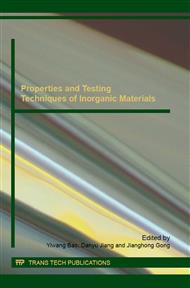p.72
p.76
p.82
p.89
p.93
p.99
p.103
p.107
p.111
Influence of Density on the Microstructure, Mechanical, Electrical and Thermal Properties of Recrystallized Silicon Carbide
Abstract:
In this paper, influence of density on the microstructure, mechanical properties, thermal and electrical properties of recrystallized silicon carbide (RSiC) were investigated via XRD, SEM, mechanical test, thermal conductivity instrument and four-probe method, etc. The results showed that the main phase of the RSiC materials was 6H-SiC; The flexural strength and modulus of elasticity of RSiC materials increased with the increase of densities, and the flexural strength of it measured at 1400 °C increased about 10%-15% compared with that of at room temperature, while the modulus of elasticity at 1400°C were lower than that of at room temperature, resulting from the weakening of binding force between the Si and C atoms at high temperature; With the increase of temperatures, the thermal conductivity of the RSiC materials decreased, while it increased with the increase of RSiC density, when density of RSiC equaled to 2.60 g·cm3, values of the thermal conductivity were 177.7 W·(m·K)1 (RT) and 28.1 W·(m·K)1(1300°C), respectively; The volume resistivity of RSiC materials dropped from 12.74 Ω·cm to 4.51 Ω·cm as the density of RSiC increased, the impurities played an more important role on this variety.
Info:
Periodical:
Pages:
93-98
Citation:
Online since:
February 2016
Authors:
Price:
Сopyright:
© 2016 Trans Tech Publications Ltd. All Rights Reserved
Share:
Citation:


